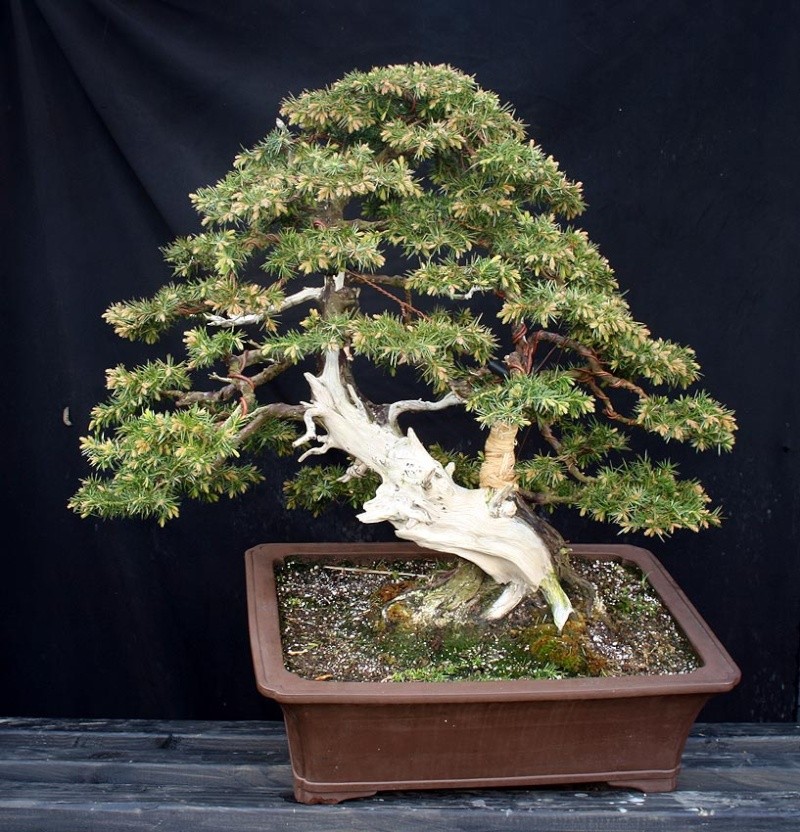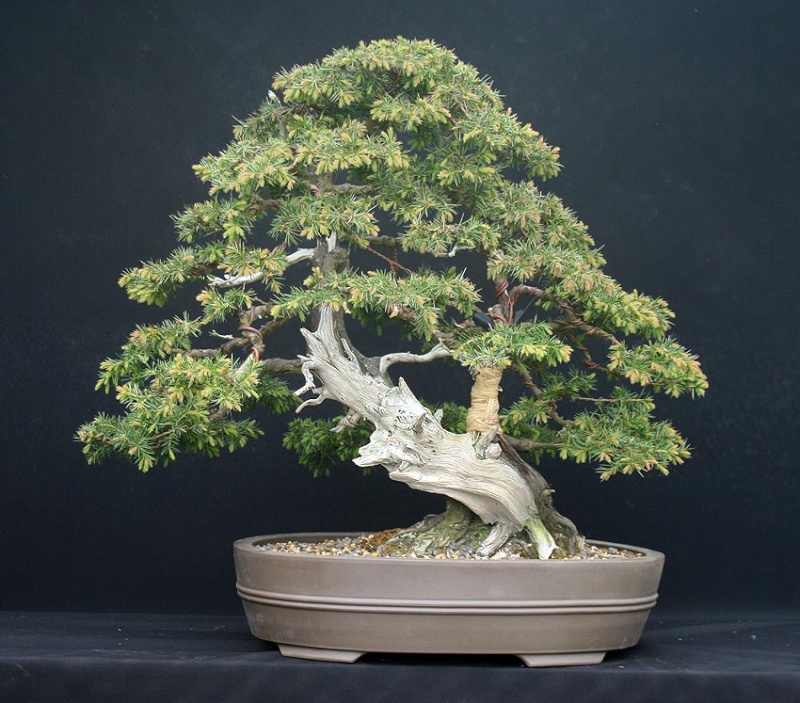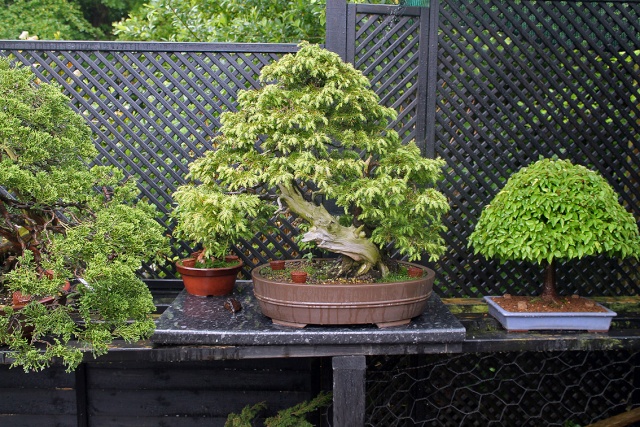Juniper Rigida - turning a branch into a trunk
+7
Gary Swiech
Sakaki
stavros
Orion
bonsaisr
Smithy
marcus watts
11 posters
Page 1 of 1
 Juniper Rigida - turning a branch into a trunk
Juniper Rigida - turning a branch into a trunk
Hi,
I've had this juniper 4 years now and have just concentrated on feeding, pinching and strengthening the tree. It came to the Uk over 40 years ago, spent at least 20 years down the road from me but was not really that happy or very strong due to fine soil, lack of feed and being kept under shade netting with a lovely collection of acers.
The earliest pictures were lost when a laptop died and fried the hard drive but all the branches were the same and there were a few sparse 3"-4" thin hanging twigs on each branch.......As it was a 'risky' purchase I agreed the price and reserved the tree but left it where it was and started feeding with Naruko, returning most weeks to turn the tree so it recieved more even light. About 10 weeks later rows of new buds were showing in and behind the weak foliage so the tree was paid for and taken home, safe in the knowledge it was going to respond ok. (Naruko is a superb japanese commercial growers fertiliser used on trees in the field and on hungry trees requiring lots of growth. It is a granular blend of organic and chemical components and used when you want to super feed a tree or build lots of strength, growth and buds rather than just slower fine growth)
for the first year I fed a lot (Naruko and my own feed cakes), let all new buds extend then cut them all back to a few mm. This triggers new smaller buds and more back buds. The strongest of the new buds are pinched short while any needed to form branches are left to grow. Repotting into a nice open soil mix in year two increased the budding and density a lot.



The above pictures are spread over 9 months from July 2011 to march this year showing quite an increase in foliage amount and density - now the tree is ready to style as there is both strength and enough actual tree to work with now- there is no point in rushing really on trees that aren't ready yet.
The front of this tree has always been the viewed angle but Peter Tea liked the back a lot more due to the more interesting dead wood. I always liked the wood at the back too but back then couldn't see how to make it fit with the existing branches.

Over the last few years I've started looking at my trees a bit differently and am happy to try big bends, large changes of angle etc so I decided to try getting the long low bottom branch upright into a second trunk. The branch felt very solid so I made a plan B in case it snapped off where a lower part of it could still be used as a branch.
where a lower part of it could still be used as a branch.
There are lots of tools you can buy, levers you can wrestle with etc when trying to bend hard branches but I find a fence strainer is one of the easiest and cheapest (£2.00) ways to bend in a slow controled way. The strainer was attached with 2mm copper wire but this snapped !! quite quickly so 2 strands of 3mm were used on each end, passed through plastic tubing for protection.


The section of wood that was going to be bent was wrapped tightly and thickly with raffia and the strainer turned steadily, pulling the branch up. I always rest finger tips on the bend when working and 3/4 of the way through I felt tiny cracking sentations (a gentle poppig vibration). Time to stop, so I waited a few hours then added a few more turns until i heard a small crack - another wait (until ther next day) and a few more turns put the branch upright.

 .
.
This transformed the right hand side of the tree, putting loads of new foliage into places it could be better used and making the tree a much nicer compact shape. Over a couple of evenings the branches were wired into place and old thin growth removed if new strong growth was close by, half way through the new form of the tree was begining to show through

The main branches were angled down and the side branches wired to form the start of flat pads. The fence strainer was replaced with a nice neat copper tension wire

and the pot was propped on a brick at the right angle and will remain sat on this brick until repotting next year. Here we have the main branches placed and the crown formed

I always find this is now the time to really study the pictures as it shows clearly the little adjustments needed to seperate the foliage from the spaces so a few pads were leveled to make the spaces underneath clearer and lots of little shoots that were growing downwards were cut off to further clean up the lines. Here is the Tosho after the first restyle in about 45 years and I love it, so much so that it has proved to me beyond all else not to rush into styling when a tree isnt ready, or when you dont have a clear idea of the finished design.
Today, 28/04/2012

compared to 26/07/2011, just 9 months ago!

This is the main methods i've used so far:
Needle juniper is a very hungry tree - feed lots from March to Sept, and water well too
Let the first flush of growth each year fully extend (4-10cm) then cut short (2mm) with very sharp scissors
Just pinch further flushes of growth that year until September, then stop pinching and let the growth harden for winter
Spring time I've thinned out dense, weak and long shoots to let in some light for the new buds to develop
These methods work very well with the other needle growth junipers too - I have a couple of the common landscape junipers and they respond in the same way to the pinching and pruning
cheers Marcus
I've had this juniper 4 years now and have just concentrated on feeding, pinching and strengthening the tree. It came to the Uk over 40 years ago, spent at least 20 years down the road from me but was not really that happy or very strong due to fine soil, lack of feed and being kept under shade netting with a lovely collection of acers.
The earliest pictures were lost when a laptop died and fried the hard drive but all the branches were the same and there were a few sparse 3"-4" thin hanging twigs on each branch.......As it was a 'risky' purchase I agreed the price and reserved the tree but left it where it was and started feeding with Naruko, returning most weeks to turn the tree so it recieved more even light. About 10 weeks later rows of new buds were showing in and behind the weak foliage so the tree was paid for and taken home, safe in the knowledge it was going to respond ok. (Naruko is a superb japanese commercial growers fertiliser used on trees in the field and on hungry trees requiring lots of growth. It is a granular blend of organic and chemical components and used when you want to super feed a tree or build lots of strength, growth and buds rather than just slower fine growth)
for the first year I fed a lot (Naruko and my own feed cakes), let all new buds extend then cut them all back to a few mm. This triggers new smaller buds and more back buds. The strongest of the new buds are pinched short while any needed to form branches are left to grow. Repotting into a nice open soil mix in year two increased the budding and density a lot.



The above pictures are spread over 9 months from July 2011 to march this year showing quite an increase in foliage amount and density - now the tree is ready to style as there is both strength and enough actual tree to work with now- there is no point in rushing really on trees that aren't ready yet.
The front of this tree has always been the viewed angle but Peter Tea liked the back a lot more due to the more interesting dead wood. I always liked the wood at the back too but back then couldn't see how to make it fit with the existing branches.


Over the last few years I've started looking at my trees a bit differently and am happy to try big bends, large changes of angle etc so I decided to try getting the long low bottom branch upright into a second trunk. The branch felt very solid so I made a plan B in case it snapped off
There are lots of tools you can buy, levers you can wrestle with etc when trying to bend hard branches but I find a fence strainer is one of the easiest and cheapest (£2.00) ways to bend in a slow controled way. The strainer was attached with 2mm copper wire but this snapped !! quite quickly so 2 strands of 3mm were used on each end, passed through plastic tubing for protection.


The section of wood that was going to be bent was wrapped tightly and thickly with raffia and the strainer turned steadily, pulling the branch up. I always rest finger tips on the bend when working and 3/4 of the way through I felt tiny cracking sentations (a gentle poppig vibration). Time to stop, so I waited a few hours then added a few more turns until i heard a small crack - another wait (until ther next day) and a few more turns put the branch upright.

 .
.This transformed the right hand side of the tree, putting loads of new foliage into places it could be better used and making the tree a much nicer compact shape. Over a couple of evenings the branches were wired into place and old thin growth removed if new strong growth was close by, half way through the new form of the tree was begining to show through

The main branches were angled down and the side branches wired to form the start of flat pads. The fence strainer was replaced with a nice neat copper tension wire

and the pot was propped on a brick at the right angle and will remain sat on this brick until repotting next year. Here we have the main branches placed and the crown formed

I always find this is now the time to really study the pictures as it shows clearly the little adjustments needed to seperate the foliage from the spaces so a few pads were leveled to make the spaces underneath clearer and lots of little shoots that were growing downwards were cut off to further clean up the lines. Here is the Tosho after the first restyle in about 45 years and I love it, so much so that it has proved to me beyond all else not to rush into styling when a tree isnt ready, or when you dont have a clear idea of the finished design.
Today, 28/04/2012

compared to 26/07/2011, just 9 months ago!

This is the main methods i've used so far:
Needle juniper is a very hungry tree - feed lots from March to Sept, and water well too
Let the first flush of growth each year fully extend (4-10cm) then cut short (2mm) with very sharp scissors
Just pinch further flushes of growth that year until September, then stop pinching and let the growth harden for winter
Spring time I've thinned out dense, weak and long shoots to let in some light for the new buds to develop
These methods work very well with the other needle growth junipers too - I have a couple of the common landscape junipers and they respond in the same way to the pinching and pruning
cheers Marcus

marcus watts- Member
dprm likes this post
 Re: Juniper Rigida - turning a branch into a trunk
Re: Juniper Rigida - turning a branch into a trunk
Hi Marcus that looks a lot better now with the work you have done and turned around.

Smithy- Member
 Juniperus rigida
Juniperus rigida
Translation department. I had never heard of a fence strainer. Then I saw the pictures. We call it a turnbuckle.
Iris
Iris

bonsaisr- Member
 Re: Juniper Rigida - turning a branch into a trunk
Re: Juniper Rigida - turning a branch into a trunk
Really nice tree. I like the approach you're taking with it; it's aggressive and brings a lot out. Interesting feed Naruko, you seem to get an excellent response with it.
Good luck with it and keep the updates flowing in.
Good luck with it and keep the updates flowing in.

Orion- Member
 Re: Juniper Rigida - turning a branch into a trunk
Re: Juniper Rigida - turning a branch into a trunk
Hey Marcus,
lovely transformation mate!!!
Love it!!
lovely transformation mate!!!
Love it!!
stavros- Member
 Re: Juniper Rigida - turning a branch into a trunk
Re: Juniper Rigida - turning a branch into a trunk
bonsaisr wrote:Translation department. I had never heard of a fence strainer. Then I saw the pictures. We call it a turnbuckle.
Iris
Hi Iris,
haha, thats why i put a close up picture in the thread as I guessed there would be many different names and versions - in our agricultural store they are fencing wire strainers and come in about 5 sizes.
hi Orion, cheers and yes, Naruko is a very good fertiliser for boosting a tree into lots of growth, bud making, leaf making etc. It is used mostly for field growing and trees in formation as it produces a lot of strong growth and vitality. (It is very good for producing multiple crops of leaves, buds and inner twigs on trees that are regularly defoliated too). I finished the Nakuro stage of this trees feeding last september and now will be making tighter short growth to form good pads so it is all T.Bags of organic blends and home made organic cakes now, but still lots of feed though as the tree is forced to make at least 3 bud breaks a year and that uses lots of energy.
Cheers everyone, i'll keep the pics coming on this one as it will be allowed to grow freely for 6-8 weeks to gain strength and should look like a shaggy mop.
Marcus
Last edited by marcus watts on Sat Apr 28, 2012 9:57 pm; edited 1 time in total

marcus watts- Member
 Re: Juniper Rigida - turning a branch into a trunk
Re: Juniper Rigida - turning a branch into a trunk
Bold and good decision for such transformation.
I have my eyes on you, Marcus
I have my eyes on you, Marcus

Sakaki- Member
 repotted
repotted
The styling went well and there had been no discolouring over the following week so I considered repotting the tree. Advice from Peter Tea was that a healthy tree can be styled and repotted all in one go, and at Aich-en they do this in May. I knew the tree was very strong and healthy as I'd spent the last 4 years building it up in readiness so we went to the local nursery on a pot hunt.
The trick with the hanging marker (in my other juniper progrression thread) was repeated to get the angle right and the roots prepared for the big tilt forward. With a tilt forward the front roots are combed out thinly and half the lower ones pruned off. At the back of the tree you do the opposite and thin and reduce the upper roots. The pot was prepared with a proper drainage layer of large particle grains and the tree tied in very tightly before medium grains were worked in around the sides. It areas where larger roots were removed a bit of sphagnum moss was mixed in too.
The tree was watered once, kept under the shade netting with the acers and has still held all its colour perfectly- (the fresh green fades to a dull look if branches are struggling).

Here she is - due to repotting the buds will slow down for another 3 weeks before extending as normal once new root tips form. We'll be first pruning in late June I think.
The trick with the hanging marker (in my other juniper progrression thread) was repeated to get the angle right and the roots prepared for the big tilt forward. With a tilt forward the front roots are combed out thinly and half the lower ones pruned off. At the back of the tree you do the opposite and thin and reduce the upper roots. The pot was prepared with a proper drainage layer of large particle grains and the tree tied in very tightly before medium grains were worked in around the sides. It areas where larger roots were removed a bit of sphagnum moss was mixed in too.
The tree was watered once, kept under the shade netting with the acers and has still held all its colour perfectly- (the fresh green fades to a dull look if branches are struggling).

Here she is - due to repotting the buds will slow down for another 3 weeks before extending as normal once new root tips form. We'll be first pruning in late June I think.

marcus watts- Member
dprm likes this post
 Re: Juniper Rigida - turning a branch into a trunk
Re: Juniper Rigida - turning a branch into a trunk
Marcus,
I really enjoyed this thread. What a nice transformation.
That Juniperus rigida didn't even see you coming.
Keep us up to date if it's not too much trouble, I'll be following this one. That's going to make a fine tree in a little time.
I really enjoyed this thread. What a nice transformation.
That Juniperus rigida didn't even see you coming.
Keep us up to date if it's not too much trouble, I'll be following this one. That's going to make a fine tree in a little time.

Gary Swiech- Member
 Re: Juniper Rigida - turning a branch into a trunk
Re: Juniper Rigida - turning a branch into a trunk
Gary Swiech wrote:Marcus,
I really enjoyed this thread. What a nice transformation.
That Juniperus rigida didn't even see you coming.
Keep us up to date if it's not too much trouble, I'll be following this one. That's going to make a fine tree in a little time.
Thanks Gary, much appreciated
Yes I will - the buds are growing nicely again now, the tree is on full feed rations and will be 1st pruned in about a month - I'll do some pictures then as some of the dead wood has been cleaned up and a couple of the weaker small branches removed as they were fading slowly after styling. It was intersting - in the shade they were staying green (but the wrong shade of green) so i moved the tree to total full sun to force the tree to show which bits were happy and which bits were slowly going to die. One week is all it took for 2 small branches and a couple of severly bent inner twigs to brown off - so they were jinned or removed. Tree looks the same so luckily all went well with the major styling.
pruning pics in 4-5 weeks
rregards Marcus

marcus watts- Member
 Re: Juniper Rigida - turning a branch into a trunk
Re: Juniper Rigida - turning a branch into a trunk
Very nice restyling Marcus! A totally different and much improved look. Congrats!

Fore- Member
 future
future
An idea to consider for the future: looking at the 2011 pics, the branch you straightened would make a nice apex as it originally was for a small cascade design, cutting away everything above this level.
DaveKirkland- Member
 Re: Juniper Rigida - turning a branch into a trunk
Re: Juniper Rigida - turning a branch into a trunk
Marcus,
What is your main soil mix for Juniperus rigida?
What is your main soil mix for Juniperus rigida?

Gary Swiech- Member
 Re: Juniper Rigida - turning a branch into a trunk
Re: Juniper Rigida - turning a branch into a trunk
Gary Swiech wrote:Marcus,
What is your main soil mix for Juniperus rigida?
Hi Gary.
Rigida likes humidity and a bit of moisture as they thrive up at high altitudes where there is a lot of mist, drizzle, low cloud etc.
For this reason I make a slightly moisture holding recipe up rather than a 'pine soil'. For my sins I use japanese components as their properties are well known and I can rely on the outcome rather than hoping or guessing. Plus I now have a small number of mature trees and tend to only repot every 5 years ++ so it doesnt break the bank
this tree is in:
30% Akadama
30% Kanuma
10% fine bark
25% expanded fired grey clay balls ( superlight, wall insulation ? not sure what it sells as abroad)
5% fresh chopped sphagnum
This mix makes great root growth, holds moisture inside the particles so humidity is high, and has great aeration. In the UK rigidas are a slightly tricky species and many are lost or just hang on very weakly with thin dropping foliage while losing random branches. For me the soil is important, misting and watering as much as my beeches and masses of feeding are both essential too as you are constantly removing new growth so the tree must be fed very hard so it does not weaken.
Hi 'Future'/ David, thanks for reading and the observation.....for me, the tree waiting to be released from the material was a twin trunk with nice taper on the main trunk line - Chopping it off to make a little stumpy tree doesn't look like an actual improvement to me, but another owner on another day may become a mad axeman, you never know
cheers Marcus

marcus watts- Member
 Re: Juniper Rigida - turning a branch into a trunk
Re: Juniper Rigida - turning a branch into a trunk
Marcus, can you expand on the type of bark you use? I know that the bark products in the UK differ from those in the USA.
Dendrogeek- Member
 Re: Juniper Rigida - turning a branch into a trunk
Re: Juniper Rigida - turning a branch into a trunk
Dendrogeek wrote:Marcus, can you expand on the type of bark you use? I know that the bark products in the UK differ from those in the USA.
Hi,
I use a fine chopped Douglas fir & pine bark that comes already sieved to a very useable 5-10mm. It is an excelent high quality product with no mess, no waste etc. I tried buying big sacks of micro landscape bark but it is a very poor comparison, needed loads of sieving and at least half is too big.
orchid/bonsai bark
cheers Marcus

marcus watts- Member
 tree update
tree update
it must be a year now since the tree went through the styling so here is a bit of an update.
winter; I left the tree out in the most exposed part of the garden and the foliage took on the bronze/brown appearance you see on japanese trees in winter. This followed a chat I was having with a friend where we said how virtually all the western bonsai junipers you see stay green year round - this got me thinking that we are potentially over protecting these trees.
the late spring here meant the tree was still bronze in early May ! and i must admit to looking a lot closer than normal at the needles to make sure they were not actually brown - what a difference the next 8 weeks and a mini heat wave makes.
Here was the tree 6th july - un-pruned so far this year, just letting the new buds extend. i think this is the most important part of the trees calender as it puts on vital strength from this period of free growth

a week later i have pruned back the new shoots with scissors to the required lengths in the upper and middle tree while the bottom branch is preserved 'as is' to give it a few more weeks strength building. I moved a cheating branch that was coming from the main trunk all the way across the 2nd trunk (behind it) so that the original tree had foliage in the lower right area - the branch was old and hard so i split it 50% so that it would move out of the way and become a back branch - the split was sealed straight away and the foliage left unpruned so it stays strong and heals fast
one week after first picture

next year i will repot again as i have changed my thoughts on soil mixes - a little research seems to show that bark depleats nitrogen as it slowly breaks down and i started asking myself why it was in the mix...ie what purpose was it providing ? my simple akadama, pumice, kiryu blend is giving best results so i'm sticking with the proven mix that visibly works rather than one that has additional bits added.
cheers
winter; I left the tree out in the most exposed part of the garden and the foliage took on the bronze/brown appearance you see on japanese trees in winter. This followed a chat I was having with a friend where we said how virtually all the western bonsai junipers you see stay green year round - this got me thinking that we are potentially over protecting these trees.
the late spring here meant the tree was still bronze in early May ! and i must admit to looking a lot closer than normal at the needles to make sure they were not actually brown - what a difference the next 8 weeks and a mini heat wave makes.
Here was the tree 6th july - un-pruned so far this year, just letting the new buds extend. i think this is the most important part of the trees calender as it puts on vital strength from this period of free growth

a week later i have pruned back the new shoots with scissors to the required lengths in the upper and middle tree while the bottom branch is preserved 'as is' to give it a few more weeks strength building. I moved a cheating branch that was coming from the main trunk all the way across the 2nd trunk (behind it) so that the original tree had foliage in the lower right area - the branch was old and hard so i split it 50% so that it would move out of the way and become a back branch - the split was sealed straight away and the foliage left unpruned so it stays strong and heals fast
one week after first picture

next year i will repot again as i have changed my thoughts on soil mixes - a little research seems to show that bark depleats nitrogen as it slowly breaks down and i started asking myself why it was in the mix...ie what purpose was it providing ? my simple akadama, pumice, kiryu blend is giving best results so i'm sticking with the proven mix that visibly works rather than one that has additional bits added.
cheers

marcus watts- Member
dprm likes this post
 Re: Juniper Rigida - turning a branch into a trunk
Re: Juniper Rigida - turning a branch into a trunk
Hi Marcus,
I agree with you about the next repotting. I wouldn't use any bark at all.
I lost a Itoigawa over the last few years due to the breakdown of the bark in the mixture.
Perhaps you can use your mix of 30% Akadama, 30% Kanuma, 25% expanded fired grey clay balls, and see how that works.
I've certainly changed my mind set concerning juniper mixes. I transplanted some of my larger Shimpaku that were turning yellow on the tips of the new growth
into a mix with no organics in them and they are bright green as they should be.
I'm using Boon's mix:
1/3 sifted "soft" akadama
1/3 sifted red lava
1/3 sifted white agricultural pumice
Some horticultural charcoal
It's a great mix for Shimpaku.
Again, very good looking tree!
I agree with you about the next repotting. I wouldn't use any bark at all.
I lost a Itoigawa over the last few years due to the breakdown of the bark in the mixture.
Perhaps you can use your mix of 30% Akadama, 30% Kanuma, 25% expanded fired grey clay balls, and see how that works.
I've certainly changed my mind set concerning juniper mixes. I transplanted some of my larger Shimpaku that were turning yellow on the tips of the new growth
into a mix with no organics in them and they are bright green as they should be.
I'm using Boon's mix:
1/3 sifted "soft" akadama
1/3 sifted red lava
1/3 sifted white agricultural pumice
Some horticultural charcoal
It's a great mix for Shimpaku.
Again, very good looking tree!

Gary Swiech- Member
 Re: Juniper Rigida - turning a branch into a trunk
Re: Juniper Rigida - turning a branch into a trunk
Hi Gary,
yes bark has no valid place in a bonsai pot i feel - just on the tree !
the fired clay balls are out for me now too - they are too large and being so light they shift while watering . i've noticed the top section of the pots not having many roots when using this mix yet my trees in a soil made up of totally even sized heavier particles are rooted solid top to bottom. This last year i've taken more care to sieve my soils using the standard 3 sieve set and now use the particles that sit on top of the middle size for the lower aeration layer and the particles that go though this sieve for the rest (minus the dust) - it is very firm and very even sized - trees potted this spring are very happy in it too.
cheers Marcus
yes bark has no valid place in a bonsai pot i feel - just on the tree !
the fired clay balls are out for me now too - they are too large and being so light they shift while watering . i've noticed the top section of the pots not having many roots when using this mix yet my trees in a soil made up of totally even sized heavier particles are rooted solid top to bottom. This last year i've taken more care to sieve my soils using the standard 3 sieve set and now use the particles that sit on top of the middle size for the lower aeration layer and the particles that go though this sieve for the rest (minus the dust) - it is very firm and very even sized - trees potted this spring are very happy in it too.
cheers Marcus

marcus watts- Member
 Re: Juniper Rigida - turning a branch into a trunk
Re: Juniper Rigida - turning a branch into a trunk
Thank you for your detailed account of this trees styling. I particularly found the part about, allowing foliage to grow during early summer and then trimming them to harden up for winter, very interesting. I've been told in the past not to trim junipers during their main growth cycle and wait, and it's those little things that you said which clarifies understanding further. cheers.

adge0001- Member
 Similar topics
Similar topics» Juniper Rigida
» Juniper rigida wiring
» Juniper needles turning brown
» How to go about turning a freshly dug up juniper (from the ground) into a bonsai
» mugo pine with needles turning yellow and buds turning black and dead?!
» Juniper rigida wiring
» Juniper needles turning brown
» How to go about turning a freshly dug up juniper (from the ground) into a bonsai
» mugo pine with needles turning yellow and buds turning black and dead?!
Page 1 of 1
Permissions in this forum:
You cannot reply to topics in this forum






